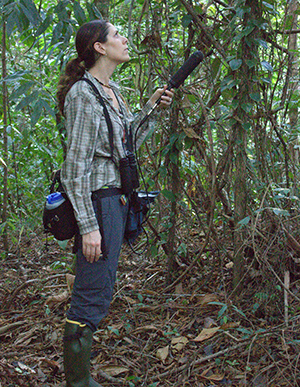
University of Wyoming Department of Zoology and Physiology Assistant Professor Corey Tarwater was among scientists on a study about how climate change can threaten species and that extinctions can affect ecosystem health.
The research details the vital importance of assessing to what degree animals can respond to changing environmental conditions -- for example, by shifting the timing of breeding -- and whether these shifts enable the persistence of populations in the long run.
To answer these questions, an international team of 64 researchers led by Alexandre Courtiol, Stephanie Kramer-Schadt and Viktoriia Radchuk, from the Leibniz Institute for Zoo and Wildlife Research (Leibniz-IZW) in Berlin, Germany, evaluated more than 10,000 published scientific studies. Although animals do commonly respond to climate change, such responses are, in general, insufficient to cope with the rapid pace of rising temperatures and sometimes go in wrong directions, according to their paper, titled "Adaptive responses of animals to climate change are most likely insufficient."
The scientific journal Nature Communications published the findings July 23.
In wildlife, the most commonly observed response to climate change is an alteration in the timing of biological events such as hibernation, reproduction or migration. Changes in body size, body mass or other morphological traits also have been associated with climate change, but, as confirmed by the study, show no systematic pattern.
The researchers extracted relevant information from the scientific literature to relate changes in climate over the years to possible changes in phenological and morphological traits. Next, they evaluated whether observed trait changes were associated with higher survival or an increased number of offspring.
Tarwater's contribution to the study extends from her postdoctoral work at the University of California- Berkeley, where she examined selection on timing of breeding in green-rumped parrotlets and how rainfall -- predicted to change with climate change -- influences timing of breeding and subsequently, fitness and population growth. Steve Beissinger, her postdoctoral adviser, runs a long-term study on parrotlets from the llanos in Venezuela.
This research took place across the globe, but primarily in the Northern Hemisphere since this is where more of this type of data has been collected.
"Although we looked widely across all taxa when evaluating changes in climate and phenotypic traits, to evaluate adaptive responses, we focused on birds because most of the work that has examined annual selection and fitness consequences has been done on birds," Tarwater says.
The overall study research, in which Tarwater contributed, focused on birds because complete data on other groups were scarce, Radchuk says.
"We demonstrate that in temperate regions, the rising temperatures are associated with the shift of the timing of biological events to earlier dates," Radchuk adds.
This suggests that species could stay in their warming habitat as long as they change fast enough to cope with climate change, says co-author Beissinger, a University of California-Berkeley professor.
Overall results were obtained by comparing the observed response to climate change with the one expected if a population would be able to adjust its traits to track climate change perfectly, says co-author Thomas Reed, a senior lecturer at University College Cork, Ireland.
Tarwater joined the study because the lead researchers wanted her to use the data and analyses she had done on parrotlets as part of the meta-analysis.
"Few long-term studies exist that allow one to examine morphological and phenological responses to climate change, and even fewer examine the consequences for individuals and populations," she says. "I was fortunate to work with this kind of data, and the lead researchers asked me to be a part of this study."
Tarwater adds that it is clear from single species studies that there will be "winners and losers" when it comes to climate change, meaning some species will be able to adapt, and others will not be able to and will be vulnerable to extinction.
"The advantage of a meta-analysis such as this one is that we have a better idea whether animals, in general, are able to shift their traits in response to selection from climatic variables, what taxa and what traits are able to shift to a greater extent, and what life stages are more vulnerable," she says. "These types of studies also highlight what we still do not know and what research is sorely needed to aid in our conservation efforts."
This work demonstrates that shifts in phenology, such as timing of breeding and migration, are more common in response to temperature compared to shifts in morphology, such as body mass, and that juveniles may be the most vulnerable, Tarwater says.
"Adults are often able to buffer themselves against shifts in climate, but juveniles are less experienced in finding food resources, escaping predators and selecting good habitat, making them more vulnerable to changes in the environment," she adds.
Given that the juvenile period strongly influences population growth, the research suggests the need to focus on this period for conservation purposes, Tarwater adds.
"The most troubling aspect to this study," Tarwater says, "is that we found even in common and abundant species that the majority of them are not able to keep pace with climate change, or they have maladaptive responses. This suggests that species with small populations, endemic species or those currently of conservation concern may really be in trouble."
The scientists hope that their analysis and the assembled datasets will stimulate research on the resilience of animal populations in the face of global change, and contribute to a better predictive framework to assist future conservation management actions.






